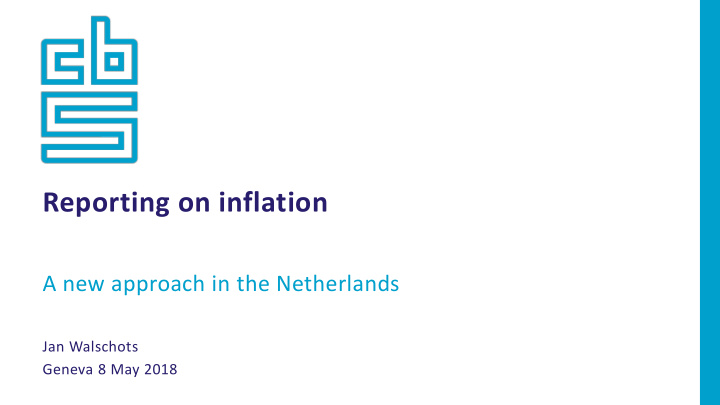



Reporting on inflation A new approach in the Netherlands Jan Walschots Geneva 8 May 2018
The use of the Consumer Price Index has developed over time In the old days, the CPI was developed to measure the cost of living of consuming households, In the past decades, the use of the CPI as a monetary measure of inflation has become ever more important In Europe, the HICP is the ECB leading indicator for inflation and for monetary policy 2
Definition of inflation Inflation is a sustained increase in the general price level What is a general price level and how can it be measured? 3
“Inflation” at Statistics Netherlands Before 2000: “inflation” was a term not used by CBS. The correct term was “the annual rate of change of the Consumer Price Index” Somewhere around 2000: “inflation” was defined as “the annual rate of change of the (national) CPI.” From June 2017: There is no longer one “inflation” outcome. 4
Reason for the change CPI is an important measure of inflation, - Consumption may be considered the ultimate goal of the production process - CPI is a rapid indicator, However, it is not a complete measure of inflation. 5
Three months of very low inflation From the past decade, I selected three months where the annual rate of the CPI became close to zero: - July 2007 – July 2009. - January 2013 – January 2015. - July 2014 – July 2016 My question to you is, do you consider that these three moments have a comparable inflation situation? Which of these three periods would indicate the largest risk of a deflationary period? 6
Annual rate of CPI 2007/07-2009/07 4 3 2 1 0 -1 -2 -3 -4 7
Annual rate of CPI 2013/01-2015/01 4 3 2 1 0 -1 -2 -3 -4 8
Annual rate of CPI 2014/07-2016/07 4 3 2 1 0 -1 -2 -3 -4 9
Three months of very low inflation ─ The person who sees low inflation of consumer prices may also be interested in buying a house. ─ The price of houses is not included in the CPI, but buying a house may be the most important expenditure decision in a person’s lifetime. ─ My question to you is, how do you consider the inflation situation if you know both the CPI and house price developments? 10
6 Annual rates 2007/07-2009/07 CPI House prices 0 4 2 0 -2 -4 -6 -8 -10 11
6 Annual rates 2013/01-2015/01 4 CPI House prices 0 2 0 -2 -4 -6 -8 -10 12
6 Annual rates 2014/07-2016/07 CPI House prices 0 4 2 0 -2 -4 -6 -8 -10 13
From inflation rate to an inflation dashboard ─ Rather than publishing one inflation rate, based on the CPI, CBS publishes an inflation dashboard combining 17 indicators ─ Based on existing price index series ─ We do not aggregate to one overall outcome 14
Why this new approach ─ Different players in the economy experience different “inflation”: consumers, enterprises, investors including homeowners, players on financial markets. ─ Price developments in various markets are very asynchronous. ─ Focus on one index series may give an erroneous view on overall inflation. 15
Which price index series are included? There are four groups in price index series included in the dashboard: - Consumption - Production - Fixed assets - Financial Markets 16
Which price index series are included? Included is: CPI For each group we selected four series: Consumption: - Food, alcohol and tobacco - Energy - Non-energy industrial goods - Services 17
Production: ─ Wages ─ Oil ─ Imports of industrial products ─ Exports of industrial goods Capital market ─ AEX stock exchange index ─ 3-months interest rate ─ 10-year government bonds ─ Gold 18
Fixed assets - Prices existing houses - Production index new dwellings - Import of machinery - Capital goods produced in the Netherlands The selection of series depends on availability and may change in the future. 19
What does the dashboard look like? 20
First overview of actual month For each of the 17 series: - Red indicates “high” inflation (e.g. houses) - Yellow indicates: “average” inflation (CPI energy; wages) - Blue indicates: “low” inflation (interest rates; CPI services) - Upper 25% of results in past decade In between 25 th and 75 th percentile - - Lower 25% of results in past decade You can choose to see this overview for each month since 2006 21
22
Second overview of time series This graph shows the numbers of red, yellow and blue in each month since 2006. Distinction between yellow above and below median - Higher inflation: column shifts up or more red - Low inflation: column shifts down or more blue - Average inflation: column in the middle and more yellow 23
Second and more flexible version You can choose a more extended version with possibilities to make own selections: - Length of reference period - Percentage of months considered red, yellow or blue Indication of how far from average and position compared to “normal” range. 24
Individual series Of course, the 17 time series of annual rates can be selected and shown individually, e.g. interest rate on 10- year government bonds: 26
Conclusion, further developments ─ First version operational since June 2017 ─ Basic approach is clear ─ More relevant series (more services, less oil) ─ Improvement of figures ─ Is exchange rate a price for the dashboard? ─ Can we make one overall indicator? 27
28
Recommend
More recommend